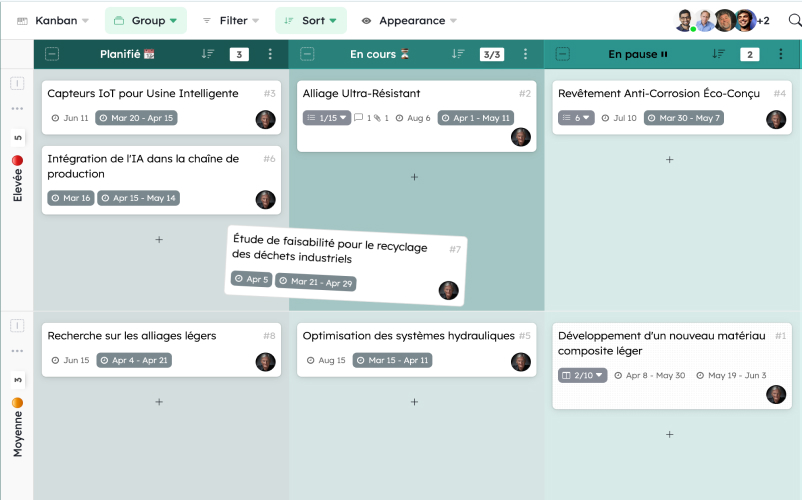10 tips to improve your productivity

In the workplace, it’s easy to get distracted, disrupted, and slowed down. Studies show this well, with some indicating that an employee is interrupted every 4 minutes. The study from the German think tank surveyed 637 employees across 25 different companies. They estimate that these interruptions cost companies 114 billion euros. Needless to say, this is far from insignificant. So, to address these practices and learn how to be more productive, we take a look at the best practices. Each point is designed so that you can implement the tips directly after reading.
Without further intro, let’s dive into the heart of the matter.
10 tips to improve your productivity at work
1- Automate repetitive tasks
Automation is key to freeing up precious time. There are several pure automation tools like Zapier or Make. These can then be connected with your current tools. Another solution is to use a project management tool like Kantree that natively includes automations to:
- Update your projects directly without leaving the application
- Generate periodic reports automatically
- Trigger predefined automated actions
 The automation editor in Kantree
The automation editor in Kantree
Pro-tip : To automate well, you need to do it manually first. Identify the tasks that take up the most time for your team and look for suitable automation solutions.
2- Adopt the Pomodoro technique
The Pomodoro technique was invented by Francesco Cirillo in the late 1980s. This entrepreneur created the technique while still a student, with the idea that regular breaks promote intellectual agility, improve concentration, and reduce mental fatigue.
Here’s the concept:
- Work in 25-minute sessions
- Take 5-minute breaks between each session
- Take a longer break every 4 sessions
Recommended tool: You don’t need much, just a timer. You can also try the free “Focus To-Do” app, which offers a more gamified experience with reports.
3- Implement an effective task management system
A good task management system is crucial for productivity. With digitalization, we can rely on existing tools to make our lives easier. As a bonus, some tools offer real-time collaboration features that allow you to easily invite your colleagues.
Let’s take a closer look at this system:
- Choose a tool that suits your team, such as Kantree, Jira, Asana, Trello, or Monday. Each has its own specificities.
- Clearly define priorities
- Assign responsibilities for each task
- Agree on deadlines beforehand
 An example of a Kanban board in Kantree
An example of a Kanban board in Kantree
Pro tip: Before testing any tool, it’s important to have a clear idea of your organizational system. A tool is never the absolute answer. The tool should only make your life easier in relation to an already established organization, saving you time.
4- Optimize your meetings
Inefficient meetings are a major productivity blocker. A study conducted by Slack with over 10,000 employees worldwide found that more than half of executives say they spend too much time in meetings.
To reduce this issue, we offer some suggestions:
- Set a clear agenda before the meeting
- Invite only essential people
- Strictly adhere to start and end times
Idea to try: You can also implement daily 15-minute “stand-up meetings” for quick and efficient check-ins. You’ll see, the creativity and energy of the participants will be different.
5- Encourage asynchronous communication
Reduce interruptions by prioritizing asynchronous communication. This is a real need felt by employees. According to a study by Opinion Way, for 1/3 of respondents, asynchronous work allows for better work/life balance, reduces fatigue, and lowers stress.
Let’s look at some practical advice:
- Use chats like Slack, Microsoft Teams, or Mattermost
- Create dedicated channels by project or theme
- Encourage the use of structured messages
Tip: All applications allow you to set specific time slots. Don’t hesitate to configure them to reserve “deep work” periods if necessary for your job.
6- Implement a centralized documentation system
Clear and accessible documentation boosts efficiency. Indeed, who hasn’t wasted time searching for a specific file and not finding it? This is even more common when a company hasn’t digitized its practices and ends up with various scattered files that are not necessarily up-to-date.
Here’s how to address this:
- Use a structured company wiki. There are different proven methods like PARA (Project, Area, Resource and Archive).
- Standardize your document structure
- Regularly update the information with the ability to trace changes
Main advantage: Reduce the time spent searching for information and answering recurring questions.
7- Adopt the “inbox zero” approach
On average, an employee receives about 144 emails per week, with this number rising to 400 for company executives. Managing emails efficiently is a real opportunity to boost productivity.
Here are 3 tips:
- Immediately handle quick emails
- Archive processed emails systematically
- Use filters and labels for automatic classification
Ultimate benefit: A clean inbox at the end of the workday provides a very satisfying feeling of accomplishing a job well done.
 The multiplication of unsuitable tools often leads to notification overload
The multiplication of unsuitable tools often leads to notification overload
8- Implement the GTD (Getting Things Done) method
The GTD method is a task management system invented in 2001 by productivity expert David Allen.
It improves time management by establishing a routine:
- Capture all tasks and ideas
- Clarify and organize your actions
- Regularly review your lists
Recommended reading: “Getting Things Done” by David Allen.
9- Use the “Eat that frog” technique
We’ve covered task management methods. With the numerous tasks we face, how can we prioritize them during the week?
Here’s how to prioritize important tasks:
- Identify your 2-3 major priorities for the week
- Schedule them first in your agenda
- Reserve a time slot each morning to address these tasks first
Metaphor: The author of this method was inspired by the Mark Twain quote below :
If the first thing you do every morning is eat a live frog, then you can go about your day with the satisfaction of knowing that this is probably the worst thing that will happen to you all day.
10- Don’t neglect regular breaks
It’s easy to want to maximize your working time to do more. In reality, regular breaks increase your efficiency and prevent mental overload; It has been scientifically proven by Dr William S. Helton.
Regular breaks increase productivity in the long term, here’s how you can implement:
- Establish screen-free lunch breaks
- Encourage micro-breaks to stretch or meditate
- Respect working hours to avoid burn-out
Conclusion
Workflow optimization is an ongoing process. Experiment with these strategies, measure the results, and adjust based on your team’s specific needs. Remember: the key to success lies in consistency and continuous adaptation.
To go further
3 possibilities offered to you if you have an interest with this subject :
-
1
Try Kantree here, it is free and you don’t need any credit card
-
2
If you want to learn more about how Kantree can adapt to your challenges, make an appointment with an expert on your use case.
-
3
Are you willing to join +1500 professionals receiving our advices and news on digitalization, collaboration, productivity? Register to our newsletter here.
If you enjoyed this article, share it easily down here.